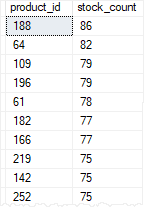Summary: in this tutorial, you will learn about the SQL Server aggregate functions and how to use them to calculate aggregates.
An aggregate function operates on a set of values and returns a single value. In practice, you often use aggregate functions with the GROUP BY clause and HAVING clause to aggregate values within groups.
The following table shows the most commonly used SQL Server aggregate functions:
| Aggregate function | Description |
|---|---|
| AVG | Calculate the average of non-NULL values in a set of values. |
| CHECKSUM_AGG | Calculate a checksum value based on a group of rows. |
| COUNT | Return the number of rows in a group that satisfy a condition. |
| COUNT(*) | Return the number of rows from a table, which meets a certain condition. |
| COUNT(DISTINCT) | Return the number of unique values in a column that meets a certain condition. |
| COUNT IF | Show you how to use the COUNT function with the IIF function to form a COUNT IF function that returns the total number of values based on a condition. |
| COUNT_BIG | The COUNT_BIG() function returns the number of rows (with BIGINT data type) in a group, including rows with NULL values. |
| MAX | Return the highest value (maximum) in a set of non-NULL values. |
| MIN | Return the lowest value (minimum) in a set of non-NULL values. |
| STDEV | Calculate the sample standard deviation of a set of values. |
| STDEVP | Return the population standard deviation of a set of values. |
| SUM | Return the summation of all non-NULL values in a set. |
| SUM IF | Use the SUM function with the IIF function to form a SUM IF function that returns the total of values based on a condition. |
| STRING_AGG | Concatenate strings by a specified separator |
| VAR | Return the sample variance of a set of values. |
| VARP | Return the population variance of a set of values. |
SQL Server aggregate function syntax
Here’s is the general syntax of an aggregate function:
aggregate_function_name( [DISTINCT | ALL] expression)Code language: SQL (Structured Query Language) (sql)In this syntax:
- First, specify the name of an aggregate function that you want to use such as
AVG,SUM, andMAX. - Second, use
DISTINCTto apply aggregate distinct values in a set; or use the ALL option to apply the aggregate function to all values including duplicates. - Third, specify the
expressionwhich can be a column of a table or an expression that consists of multiple columns with arithmetic operators.
SQL Server aggregate function examples
We will use the products table from the sample database for the demonstration.

The AVG function example
The following statement uses the AVG() function to return the average list price of all products in the products table:
SELECT
AVG(list_price) avg_product_price
FROM
production.products;Code language: SQL (Structured Query Language) (sql)The following shows the output:
avg_product_price
-----------------
1520.591401Code language: CSS (css)Because the list price is in USD, it should have at most two decimal places. Therefore, you need to round the result to a number with two decimal places.
To achieve this, you use the ROUND and CAST functions as demonstrated in the following query:
SELECT
CAST(ROUND(AVG(list_price),2) AS DEC(10,2))
avg_product_price
FROM
production.products;Code language: SQL (Structured Query Language) (sql)Output:
avg_product_price
-----------------
1520.59Code language: CSS (css)In this query:
- First, the
ROUNDfunction returns the rounded average list price. - Then the
CASTfunction converts the result to a decimal number with two decimal places.
The COUNT function example
The following statement uses the COUNT() function to return the number of products whose price is greater than 500:
SELECT
COUNT(*) product_count
FROM
production.products
WHERE
list_price > 500;Code language: SQL (Structured Query Language) (sql)Output:
product_count
-------------
213In this example:
- First, the
WHEREclause gets products whose list price is greater than 500. - Second, the
COUNTfunction returns the number of products with list prices greater than 500.
The MAX function example
The following statement uses the MAX() function to return the highest list price of all products:
SELECT
MAX(list_price) max_list_price
FROM
production.products;Code language: SQL (Structured Query Language) (sql)Output:
max_list_price
--------------
11999.99Code language: CSS (css)The MIN function example
Similarly, the following statement uses the MIN() function to return the lowest list price of all products:
SELECT
MIN(list_price) min_list_price
FROM
production.products; Code language: SQL (Structured Query Language) (sql)Output:
min_list_price
--------------
89.99Code language: CSS (css)The SUM function example
To demonstrate the SUM() function, we will use the stocks table from the sample database.

The following statement uses the SUM() function to calculate the total stock by product id in all warehouses:
SELECT
product_id,
SUM(quantity) stock_count
FROM
production.stocks
GROUP BY
product_id
ORDER BY
stock_count DESC;Code language: SQL (Structured Query Language) (sql)The following picture shows the partial output:

How the statement works:
- First, the
GROUP BYclause summarized the rows by product id into groups. - Second, the
SUM()function calculated the sum of quantity for each group.
The STDEV function example
The following statement uses the STDEV() function to calculate the statistical standard deviation of all list prices:
SELECT
CAST(ROUND(STDEV(list_price),2) as DEC(10,2)) stdev_list_price
FROM
production.products;Code language: SQL (Structured Query Language) (sql)Output:
stdev_list_price
----------------
1612.15Code language: CSS (css)Summary
- Aggregate functions operate on rows and return a single row.
- Use aggregate functions with the
GROUP BYclause to aggregate values within groups. - Use the
AVG()function to calculate the average of values. - Use the
SUM()function to calculate the total of values. - Use the
COUNT()function to count the number of values in a column. - Use the
MIN()function to get the minimum value in a set. - Use the
MAX()function to get the maximum value in a set.